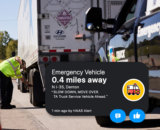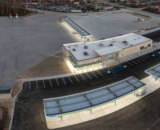The use of kiosk ordering and self-checkout lanes, which are often referred to as frictionless payments, has increased, and the public is getting used to using them everywhere from grocery stores to movie theaters and restaurants. For retailers, self-service technology can increase speed-of-service, allow them to reassign labor and improve order accuracy.
Self-check-out is everywhere. You can’t go somewhere without seeing self-checkout. Today’s consumers are trained to use it.
“Self-check-out is everywhere. You can’t go somewhere without seeing self-checkout,” said Karen Dyer, product marketing manager for Gilbarco. “Today’s consumers are trained to use it.”
Customer needs and expectations, consumer preference, the challenges associated with labor management and the need for operational efficiencies are all contributing to the trend, Dyer said. What’s more, today’s customers expect convenience, personalization, speed, efficiency, empowerment and seamlessness, which can be a tall order to fill.
“Retailers have to be thinking about technology,” Dyer added.
Darren Schulte, vice president of membership for NATSO, said kiosk ordering and cashier-less technology is gaining traction. “We know these technologies are taking over in Europe,” he said.
Adressing Labor Needs
Schulte said more and more NATSO members are looking into the technology, which in many cases is driven by labor issues truckstop and travel plaza operators face. “It isn’t to replace labor, it is to reassign labor, free up labor for other areas, or because they are having a hard time finding labor,” he said.
Finding the right people to hire, effectively onboarding employees and managing labor can be challenging for retailers, Dyer said.
The unemployment rate has gone down over the past 10 years.
“It is getting harder and harder to employ people and get good employees. The people who want to work are working and there aren’t people left floating around looking for jobs,” Dyer said. “The cost to onboard employees is high but also the cost to find employees and get them hired is high.”
In addition, there is an ongoing trend of increasing minimum wage, Dyer said. The National Conference of State Legislatures reported that 18 states started the new year with higher minimum wages in 2019. The same held true for 2018, and in 2017, 19 states started the year with higher minimum wages.
FRICTIONLESS PAYMENTS
Frictionless payments are a method of using data from devices, apps and websites to integrate buying opportunities as simply and seamlessly as possible into consumers’ everyday activities and natural environments. Within the U.S., Dwayne Hoffman, senior director of franchise development for Nathan’s Famous, said the move to kiosk solutions is almost a necessity due to the cost of labor. “State wages are going up. Federal wages are going up. It is a very, very thin line between making a profit or not making a profit sometimes,” he said. Source: Tech Target
Dyer added that she often hears employers struggle with simply getting their employees to show up. “Technology shows up every day. It doesn’t call out. We see that with labor challenges, dependability and consistency is key.”
However, Dyer said it is important to remember that frictionless payments don’t mean employee-less operations, and she said operators should consider how they can best use their employees. Labor may be better deployed making food, making sure fresh food is out, cleaning restrooms, stocking shelves, welcoming customers and focusing on the high customer delight activities, she explained.
“Checking out is the last thing customers remember about your store. If they have a bad experience at the end, that is what they’ll remember,” Dyer said, adding that operators should consider what their customers need and then work backwards. “If you can have a great experience for them, they’ll have a more positive connection with your location.”
ADDING CONVENIENCE WITH PUSH- BUTTON TECHNOLOGY
Dyer said operators want to increase their top line and revenue, which requires them to build their customer base and loyalty. To do that, they have to improve their customer service, speed of service and convenience. “They need to make sure they’re taking care of their customers, so their customers want to come back,” she said.
Kiosks can give customers options, and several convenience stores have already embraced the kiosk ordering trend. “Self-ordering at quick service is becoming very prominent,” Dyer said.
Checking out is the last thing customers remember about your store. If they have a bad experience at the end, that is what they’ll remember.
Wawa, Rutter’s and Sheetz all have the technology. Big box and grocery chains have also added it. Costco, for example, has announced it was testing four self-service food kiosks in its food courts. The technology is increasing in the quick-service segment. Large chains, such as Wendy’s and McDonalds, have installed screens at some locations.
Nathan’s Famous has three kiosks located in the United Kingdom. “It seems that the European market is very adaptable to the self-ordering kiosk market. They’re at that tipping point where they expect to find a kiosk to order,” Hoffman said.
Nathan’s Famous has plans in the works to install kiosks in two domestic locations. “One is in a heavy lunchtime location,” he said, adding that it is at a military base and can see 200-300 visitors during the lunch rush. “We think the kiosk will offset the register line,” Hoffman said.
In addition, kiosks can also spur sales. “What we’ve seen on the initial sites is every one of the kiosk orders is much higher than if they were to order at the register,” Hoffman said. “All of those add-ons you can add do add up. Maybe you go from an $8 to $10 order to a $15 order very easily.”
Gilbarco has several alternate payment options for its customers, both at the dispenser and inside, Dyer said.
Gilbarco’s food-service solution for express ordering can be used as a stand-alone product or it can connect with other Gilbarco products. For example, it can link to the kitchen as well as a Gilbarco Passport System to show if an order is paid. It can also link to Passport Edge.
One challenge with kiosk technology is that there isn’t an industry standard, Schulte said. Because systems differ, customers don’t always know what they can or can’t do at a specific location.
“With Wawa and Sheetz, you have a lot of opportunity to add or subtract items off of the menu. At Speedway, that isn’t the case,” Schulte said, speaking from personal experience. “I thought I’d be able to do what I’d done at the others.”
For operators looking into a kiosk program, Schulte recommends they research systems and look for mainstream options other retailers are using.
SKIPPING THE LINE
Consumers are getting more and more used to self-checkout lanes. Big box re-tailers including Walmart and Target as well as most local grocery stores have the technology.
Juan Galarraga, Target’s senior vice president of store operations, has said that not all guests love self-checkout, but about a third of its customers currently use self-checkout and love the option.
Gilbarco has a self-checkout system that became available this fall after two years of testing. “It’s primary purpose is to help retailers improve the customer experience. It allows existing staff to better service their customers’ needs,” Dyer said.
Chris Heinz, director of operations and finance for Coffee Cup Fuel Stops, has installed self-checkout lanes through the Comdata solution at one of the company’s locations. The other locations will be installing NCR’s cash/credit/debit solution, which is what is available at Walmart and Hy- Vee, Heinz said.
Heinz worked with Comdata two years ago to make a Smartdesq work as a credit/debit only self-checkout. “We are getting around 12 to 14 percent of our inside transactions going through the self-checkouts,” he said.
At that location, one person covers one manned POS and two self-check- outs, so Coffee Cup was able to reduce labor. “We’re also able to get the customers who are accustomed to and prefer using them elsewhere out of the line, which makes for a better experience for them, as well as those who need to be in the line,” Heinz said.
The challenge has been that the Smartdesq set up is not as recognizable as a self-checkout that the large retailers have, Heinz said. “We have a light, but it still doesn’t look the same so customers will overlook them,” he explained. “We also are credit/debit only and we need at least one cash/ credit/debit as it can create frustration for someone getting out of the line to pay with cash, only to realize it’s credit only. The light says credit/debit only but that goes back to customers being creatures of habit.”
LOOKING AT OTHER OPTIONS
Some retailers are implementing scan- and-go technology, and shoppers can scan items as they add them into their cart and pay via credit. Amazon Go has taken frictionless to the next level, and customers can scan their phone when they walk in, add items to their cart and walk out. While it is convenient, Dyer said that type of technology can be cost prohibitive to many retailers. “You have to consider what all of the technology and the monitoring costs,” she said.
Chick-fil-a is one example of a fast food restaurant using mobile employee workstations. Employees often take orders in the drive through to help speed customers along. In 2020, Gilbarco plans to introduce Passport Flex, which uses mobile line ordering to help move customers along faster.
GAUGING CUSTOMER REACTIONS
How customers react to frictionless payment options can vary based on person- al as well as situational preference. Dyer said that can range from whether the person wants to interact with a human or not, if the shopper is in a leisurely state or a hurry, or if the shopper has only a few items or a full cart.
Truckstop and travel plazas cater to multiple types of customers, including those that are in a hurry as well as those that have time to spend in the location. “At that 7:00 a.m. rush, everyone is running to get coffee. They’re in a hurry,” Dyer said. “The after-school mom coming to get an ice cream or a peanut butter and jelly sandwich has more time. It isn’t black and white. It is very grey.”
Heinz said he has seen that customers are receptive to self-serv options, and he expects acceptance to grow. “As more retailers install them and reduce their labor accordingly, it will be what customers must do so there will be little choice, unless we have a change in the labor market,” Heinz said.
MAKING INFORMED DECISIONS
Operators need to consider the cost and the maintenance associated with frictionless payments, including the
technology itself, overhead and potential shrink costs, Dyer said. They also have to factor in rules and regulations for their particular location, which can include card data regulations, sales of restricted items, and weights and measures requirements. “It is really important to make sure that whatever is implemented meets all of the rules and regulations,” she explained.
They also need to look at synergies between all of their tech equipment,
Dyer said. Otherwise, operators end up with two disparate systems and that create even more cost and overhead. She explained that Gilbarco's self checkout and kiosk options connect effortlessly. “We’re trying to make sure whatever new we do integrates seamlessly with the technology operators already have integrated,” Dyer said.
Subscribe to Updates
NATSO provides a breadth of information created to strengthen travel plazas’ ability to meet the needs of the travelling public in an age of disruption. This includes knowledge filled blog posts, articles and publications. If you would like to receive a digest of blog post and articles directly in your inbox, please provide your name, email and the frequency of the updates you want to receive the email digest.

